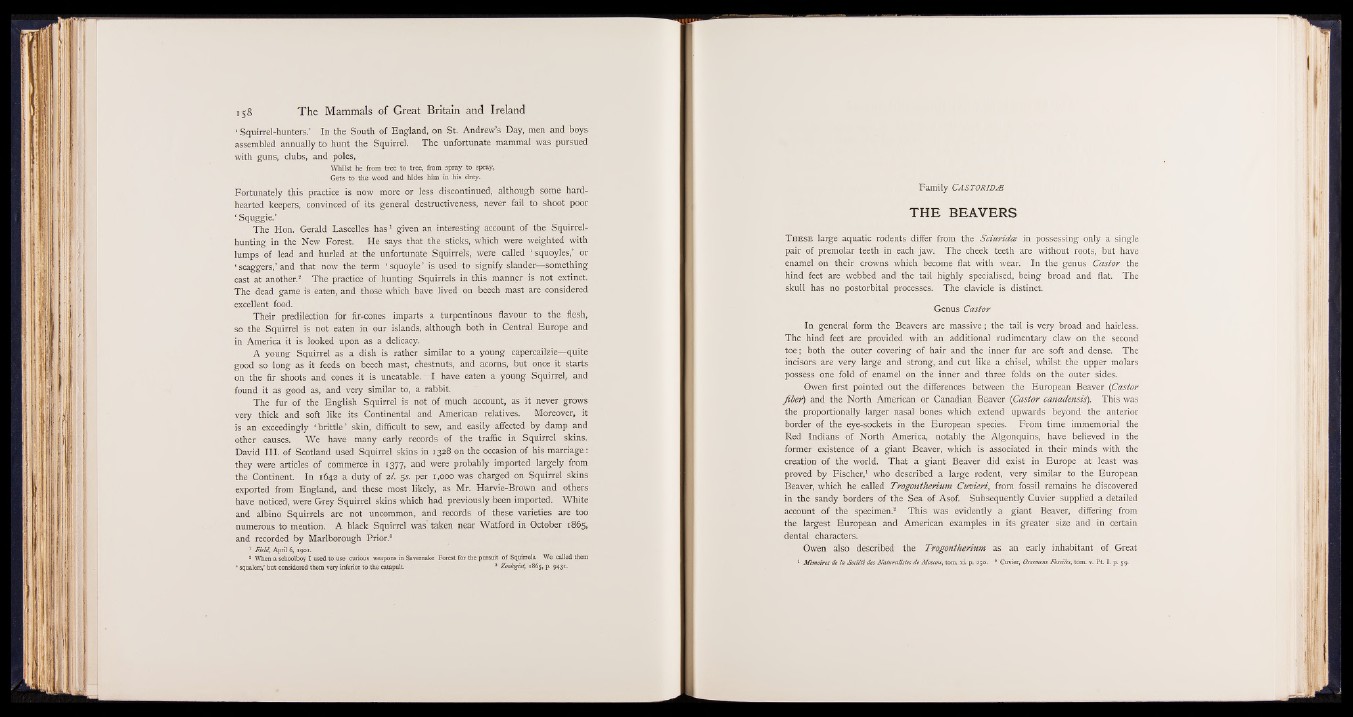
* Squirrel-hunters.’ In the South of England, on St. Andrew’s Day, men and boys
assembled annually to hunt the Squirrel. The unfortunate mammal was pursued
with guns, clubs, and poles,
Whilst he from tree to tree, from spray to spray,
Gets to the wood and hides him in his drey.
Fortunately this practice is now more or less discontinued, although some hardhearted
keepers, convinced of its general destructiveness, never fail to shoot poor
‘ Squggie.’
The Hon. Gerald Lascelles has1 given an interesting account of the Squirrelhunting
in the New Forest. He says that the sticks, which were weighted with
lumps of lead and hurled at the unfortunate Squirrels, were called ‘ squoyles,’ or
‘ scaggers,’ and that now the term ‘ squoyle ’ is used to signify slander—something
cast at another.2 The practice of hunting Squirrels in this manner is not extinct.
The dead game is eaten, and those which have lived on beech mast are considered
excellent food.
Their predilection for fir-cones imparts a turpentinous flavour to the flesh,
so the Squirrel is not eaten in our islands, although both in Central Europe and
in America it is looked upon as a delicacy.
A young Squirrel as a dish is rather similar to a young capercailzie—quite
good so long as it feeds on beech mast, chestnuts, and acorns, but once it starts
on the fir shoots and cones it is uneatable. I have eaten a young Squirrel, and
found it as good as, and very similar to, a rabbit.
The fur of the English Squirrel is not of much account, as it never grows
very thick and soft like its Continental and American relatives. Moreover, it
is an exceedingly ‘ brittle ’ skin, difficult to sew, and easily affected by damp and
other causes. We have many early records of the traffic in Squirrel skins.
David I I I. of Scotland used Squirrel skins in 1328 on the occasion of his marriage:
they were articles of commerce in 1377, and were probably imported largely from
the Continent. In 1642 a duty of 2/. 55. per 1,000 was charged on Squirrel skins
exported from England, and these most likely, as Mr. Harvie-Brown and others
have noticed, were Grey Squirrel skins which had previously been imported. White
and albino Squirrels are not uncommon, and records of these varieties are too
numerous to mention. A black Squirrel was taken near Watford in October 1865,
and recorded by Marlborough Prior.8
1 Field, April 6, 1901.
2 When a schoolboy I used to use curious weapons in Savemake Forest for the pursuit of Squirrels. We called them
‘ squalers,’ but considered them very inferior to the catapult * Zoologist, 1865, p. 9431.
Family CASTOKWÆ
THE BEAVERS
T h e s e large aquatic rodents differ from the Sciuridee in possessing only a single
pair of premolar teeth in each jaw. The cheek teeth are without roots, but have
enamel on their crowns which become flat with wear. In the genus Castor the
hind feet are webbed and the tail highly specialised, being broad and flat. The
skull has no postorbital processes. The clavicle is distinct.
Genus Castor
In general form the Beavers are massive ; the tail is very broad and hairless.
The hind feet are provided with an additional rudimentary claw on the second
toe; both the outer covering of hair and the inner fur are soft and dense. The
incisors are very large and strong, and cut like a chisel, whilst the upper molars
possess one fold of enamel on the inner and three folds on the outer sides.
Owen first pointed out the differences between the European Beaver ((Castor
fib er) and the North American or Canadian Beaver ((Castor canadensis). This was
the proportionally larger nasal bones which extend upwards beyond the anterior
border of the eye-sockets in the European species. From time immemorial the
Red Indians of North America, notably the Algonquins, have believed in the
former existence of a giant Beaver, which is associated in their minds with the
creation of the world. That a giant Beaver did exist in Europe at least was
proved by Fischer,1 who described a large rodent, very similar to the European
Beaver, which he called Trogontherium Cuvieri, from fossil remains he discovered
in the sandy borders of the Sea of Asof. Subsequently Cuvier supplied a detailed
account of the specimen.2 This was evidently a giant Beaver, differing from
the largest European and American examples in its greater size and in certain
dental characters.
Owen also described the Trogontherium as an early inhabitant of Great
1 Mémoires de la Société des Naturalistes de Moscou, tom. xi. p. 250. * Cuvier, Ossemens Fossiles, tom. v. PL I. p. 59.